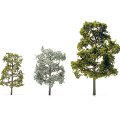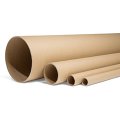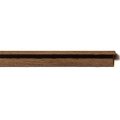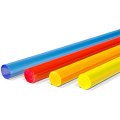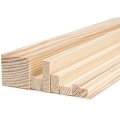Model trees
Informationen über Modellbäume
It is difficult to imagine architectural models without trees because trees supply the models with a sense of scale. On the other hand, there is probably no other depictive component so capable of distorting that sense of scale: if the tree is too small or its crown has too small a diameter the adjacent building will appear much taller or more colossal than intended. One should always try - even in the case of very small scales - to use model trees with visible trunks as they will help create a sense of openness and transparency. As a frame of reference, the following table shows the usual height of some full grown trees:
|
Spruce, pine, fir |
30 - 40 |
|
Beech, elm |
30 - 40 |
|
Oak, poplar (cottonwood) |
25 - 35 |
|
Maple, lime, plane (sycamore) |
20 - 30 |
|
Old fruit trees |
8 - 10 |
|
Fruit tree plantation |
4 - 5 |
There are, however, other considerations. The type of material and its colour also influences the appearance of tree size. The heavier or more massive the material appears, the smaller should be the crown size chosen. One should also take into account the proportional relationship between the trunk and the crown. In larger scale models - say, bigger than 1:200 - "lighter" model trees should be used: lifelike trees (Foster Trees), Achillea (yarrow), Iceland lichen, steel wool, fine wire mesh, "plant foam" (polyurethane soft foam), etc. For smaller scale models, a more abstract representation can be accomplished by using balls or spheres made from cotton, sponge, cellular rubber, wood, needles, etc. (Some of this information comes from the book "ARCHITEKTUR-MODELLE" (in German))
If model trees are indeed to be used in your model, the following proportional relationships between the model tree crown sizes and the real tree crown sizes should be noted (see table).
|
Ø Tree Crown in Model [mm] |
|||||
|
Ø Crown [m] |
1:1000 | 1:500 | 1:200 | 1:100 | 1:50 |
| 5 | 5 | 10 | 25 | 50 | 100 |
| 10 | 10 | 20 | 50 | 100 | 200 |
| 15 | 15 | 30 | 75 | 150 | 300 |
Naturalistic Model Trees
There is no better alternative for the naturalistic representation of landscape elements than trees made from etched brass. The process for manufacturing the trees is very interesting: first, the two-dimensional framework for the branches is etched from thin sheet brass. This framework is then bent into the three-dimensional shape of the tree and covered with special flock. For trees with heights ≤ 37 mm, the thin sheet stem (trunk) is simply dipped in paint – in order to "plant" the foliage on it, slits must be cut into the foundation sheet. It is only in the case of larger trees with heights of more than 42 mm that the tree’s crown has a brass wire attached, which then has a larger trunk modelled around it.
When comparing these trees with other "lifelike" products the most obvious difference, besides the exemplary shape, is the quality of the colours. The colour tones of the deciduous trees are indeed the same as those of a tree blooming in summertime while the conifers have exactly the same subtle black-green tones of the real ones. The pastel shade of the blue-green deciduous trees looks remarkably similar to that of the trees used by the famous architect Norman Foster in his models!
The palm trees are especially eye-catching because, regardless of scale, their green painted fronds possess precisely the right relationship between the thickness of the material and the size of the leaves to convey a sense of being real. The finely cross-grooved trunks with the inflorescence at the top are only missing the coconuts!
In addition to the etched brass trees in stock there are also Scots pine, birch and red beech trees available for ordering. The trunk of the birch tree has a whitish colour and the boughs, with their light green leaves, hang in the typical birch manner. The red beech is much like all the etched deciduous trees except that its foliage is painted reddish brown.
The producer of the etched brass trees also has less expensive string and wire trees on offer. These are produced with wires into which sisal fibres are wound in such a way as to form a brush (as with the bristle trees) which is then cut to shape and finally provided with a thicker stem for the trunk and with foliage or needles as required.
In the cases of poplars and the even more pointy-shaped cypresses the string and wire process produces excellent likenesses. Less impressive are the results for deciduous trees and conifers like the spruce. All the string and wire trees use the same type of flock material as their etched counterparts for foliage – they too have the same beautiful colours! The poplars and the deciduous trees are dressed in gleaming summer green while the cypresses and conifers wear their renowned black-green robe.


